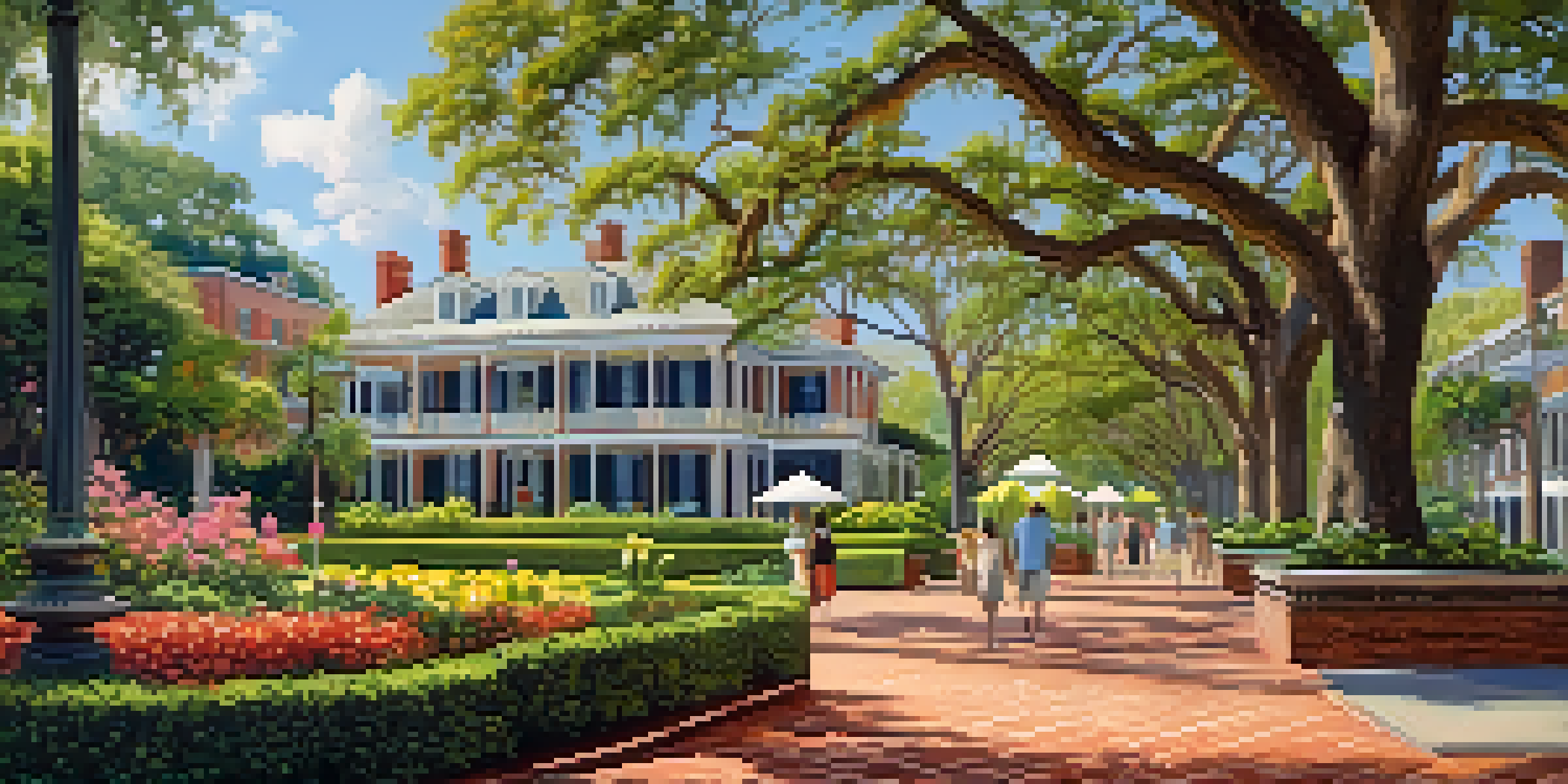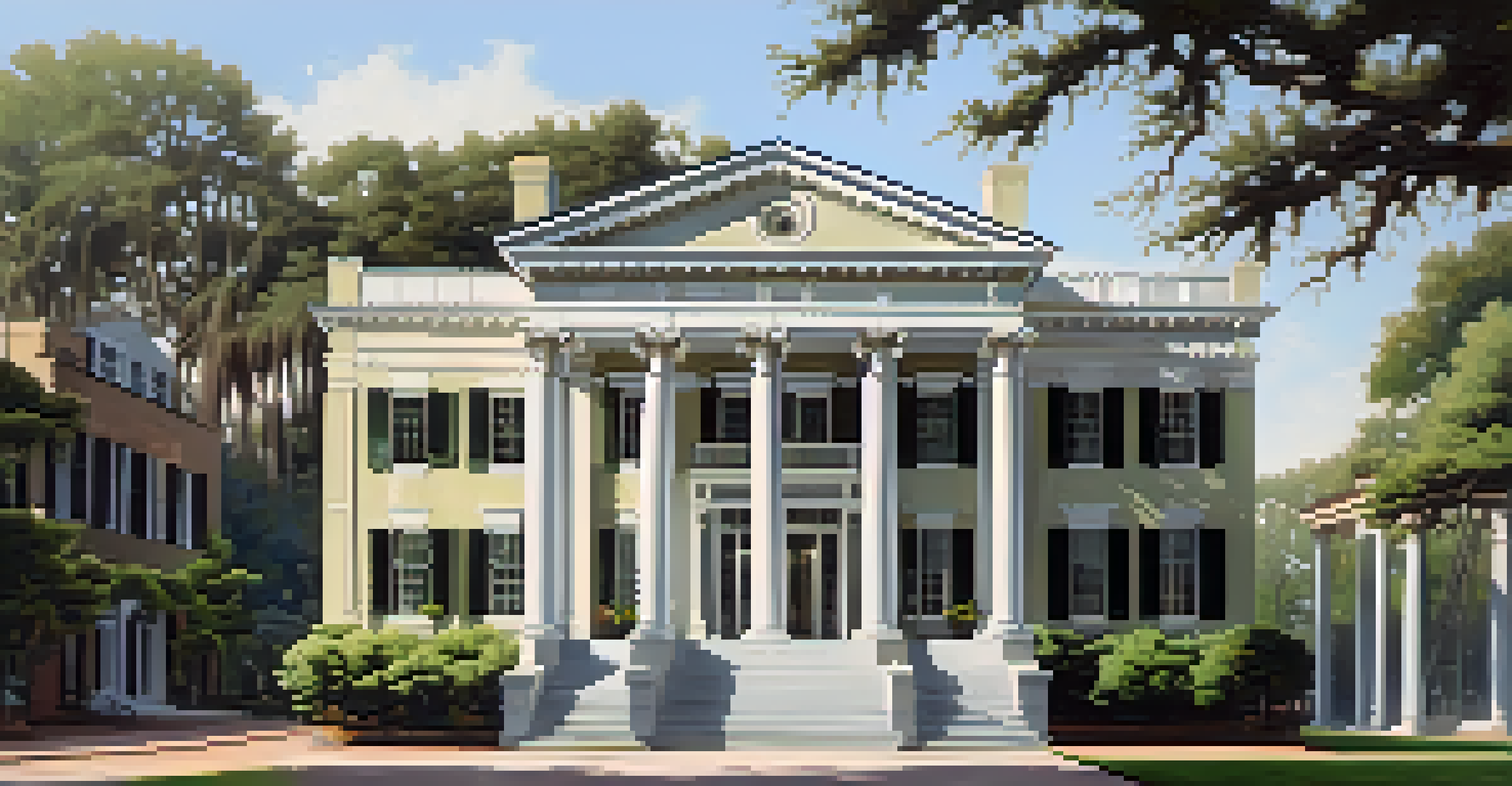Savannah's Architectural Styles: A Blend of Cultures

A Brief Introduction to Savannah's Architectural Heritage
Savannah, Georgia, is a city steeped in history, and its architecture reflects a unique blend of cultures and influences. From the colonial era to modern times, the city has absorbed various styles that tell stories of its diverse inhabitants. Walking through Savannah feels like stepping into a living museum, where each building offers a glimpse into the past.
Architecture is the learned game, correct and magnificent, of forms assembled in the light.
The city’s layout, designed in the 18th century, features a series of squares that are surrounded by stunning architecture. This intentional design reflects the city’s commitment to community and aesthetics, illustrating how the built environment can enhance social interaction. Each square is a focal point of local life, showcasing various architectural styles.
As you stroll through the streets, you’ll notice elements from different eras and cultures, which all contribute to Savannah's unique character. This architectural tapestry not only highlights the city's historical significance but also serves as a testament to the evolution of its inhabitants and their values.
Colonial Influences: The Foundation of Savannah’s Style
The roots of Savannah's architectural styles can be traced back to its colonial past, primarily influenced by British settlers. These early designs often showcased symmetrical proportions and classic elements, reflecting the aspirations of the time. The use of tabby concrete, a material made from oyster shells, is one distinctive feature that you’ll find in some of the oldest structures.

Colonial homes, with their large porches and elevated foundations, were built to adapt to the humid climate, providing both comfort and practicality. This style laid the groundwork for many future developments in the city. The architectural choices made during this period continue to influence modern designs, echoing a timeless elegance.
Savannah's Rich Architectural History
Savannah's architecture tells a captivating story of its diverse cultural influences from colonial times to the modern era.
You can see the remnants of these colonial influences in several historic buildings, like the Owens-Thomas House, which exemplifies the grace of the era. As Savannah grew, these early architectural choices paved the way for a rich blend of styles that would follow.
The Greek Revival Style: A Touch of Elegance
In the early 19th century, Savannah embraced the Greek Revival style, which mirrored the nation’s growing interest in democracy and classical ideals. This architectural choice was characterized by grand columns, pediments, and intricate details that evoke the grandeur of ancient Greece. Many of the city’s most iconic buildings, like the Telfair Academy, showcase this elegant style.
A building is not just a place to be but a way to be.
The use of white paint and large windows in Greek Revival architecture allowed for plenty of natural light, creating a bright and welcoming atmosphere. These structures often served as public buildings, reflecting the city’s commitment to civic pride and cultural development. The choice of this style was not merely aesthetic; it also symbolized a connection to the ideals of liberty and enlightenment.
As you explore Savannah, you’ll find that the Greek Revival style adds a layer of sophistication to the city’s architectural landscape. It stands as a reminder of a time when architecture was not just about function but also about expressing cultural values.
Victorian Architecture: A Flourish of Creativity
The Victorian era brought a surge of creativity and embellishment to Savannah’s architecture, characterized by intricate details and diverse styles. From Queen Anne to Gothic Revival, the Victorian influence introduced vibrant colors, ornate trim, and asymmetrical designs. This period marked a shift towards more personalized and unique residential buildings.
Victorian homes often featured wrap-around porches, stained glass windows, and intricate woodwork, making them stand out in the cityscape. These elements not only enhanced the aesthetic appeal but also reflected the social status of their owners. The architecture of this era invites curiosity and admiration, showcasing the craftsmanship of the time.
Preservation of Historical Charm
Efforts by organizations like the Historic Savannah Foundation are crucial in maintaining the integrity and charm of the city’s architectural heritage.
One of the best examples of this style can be seen in the Mercer-Williams House, which combines various Victorian elements into a stunning architectural statement. The Victorian influence adds a layer of charm and character to Savannah, making it a delight for architecture enthusiasts.
The Impact of the Spanish Colonial Revival Style
The Spanish Colonial Revival style made its mark on Savannah in the early 20th century, adding a distinct flair to the city’s architectural diversity. This style is characterized by stucco exteriors, red-tiled roofs, and arched doorways, reminiscent of the Spanish missions and haciendas. The influence of this style is particularly evident in the design of public buildings and homes in the historic district.
The revival of these Spanish elements was part of a broader trend that sought to celebrate the cultural heritage of the American Southwest and Latin America. It represented a shift towards more eclectic designs, where architects began to blend different styles to create something unique. This fusion is what makes Savannah’s architecture so captivating.
You can admire the Spanish Colonial Revival at places like the Cathedral of St. John the Baptist, where the intricate details and vibrant colors create a stunning visual impact. This style adds to the rich tapestry of Savannah’s architectural narrative, highlighting the city’s ability to embrace and celebrate diverse influences.
Modernism: A New Chapter in Savannah’s Design
As the 20th century rolled in, Savannah began to see the rise of modernism in its architectural landscape, bringing a departure from traditional styles. Modern architecture focuses on simplicity, functionality, and the use of new materials, often featuring clean lines and open spaces. This shift represented a move towards innovation and a reflection of contemporary values.
Incorporating glass, steel, and concrete, modern buildings often contrast sharply with the historic structures that dominate the city. However, this juxtaposition creates a compelling dialogue between the old and the new, showcasing Savannah’s ability to evolve while honoring its past. The inclusion of modern design elements is a testament to the city's dynamic nature.
Eclectic Styles Reflect Community Values
The blend of architectural styles in Savannah, from Greek Revival to Modernism, showcases the city's evolving identity and the values of its inhabitants.
One notable example of modern architecture in Savannah is the SCAD Museum of Art, which blends contemporary aesthetics with historical context. This integration of modernism into Savannah’s architectural fabric demonstrates that the city is not just a keeper of history but also a participant in an ongoing architectural conversation.
Preservation Efforts: Keeping Savannah’s Charm Alive
With such a rich architectural heritage, preservation efforts in Savannah are crucial to maintaining the city’s charm and historical significance. Organizations like the Historic Savannah Foundation work tirelessly to protect and restore historic buildings, ensuring that future generations can enjoy this architectural treasure. Their efforts highlight the importance of safeguarding cultural landmarks.
Preservation not only involves maintaining the physical structures but also encompasses the stories and memories they hold. By conserving these buildings, Savannah retains its identity and connection to the past, allowing residents and visitors alike to appreciate the city’s unique character. It’s a labor of love that reflects a deep respect for history.

As you explore Savannah, you’ll notice signs of restoration and care taken to preserve the architectural integrity of the city. This commitment to preservation ensures that Savannah’s diverse architectural styles will continue to tell their stories for years to come, enriching the experience of everyone who walks its streets.
Conclusion: A Tapestry of Architectural Styles in Savannah
Savannah's architectural landscape is a vibrant tapestry woven from various cultural influences and historical eras. Each style, from Colonial to Modernism, contributes to the city’s unique identity, making it a fascinating place to explore. The blend of these architectural styles reflects the rich history and diverse cultures that have shaped Savannah over the centuries.
As you walk through the city, you’re not just observing buildings; you’re experiencing a narrative of resilience, creativity, and community. The architecture serves as a reminder of the values and aspirations of those who came before us, inviting us to appreciate the beauty of our collective history. Savannah stands as a testament to how architecture can encapsulate the essence of a place.
In conclusion, Savannah's architectural styles are more than just aesthetics; they are a celebration of the city’s past and present. Whether you’re an architecture buff or a casual visitor, Savannah’s buildings will leave you inspired and connected to the rich stories they tell.